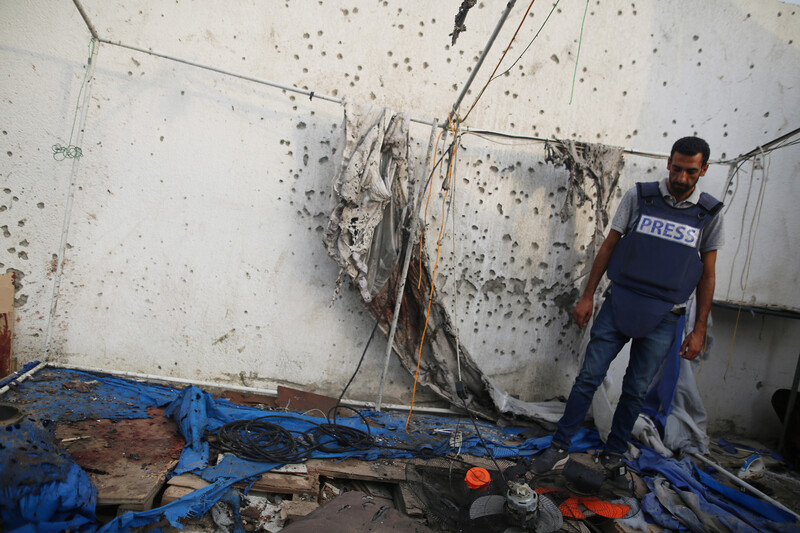Rights and Accountability 15 August 2025

Israel assassinated six reporters, including Al Jazeera’s Anas Al-Sharif and Mohammad Qreiqeh, while they were inside their media tent in the courtyard of Al-Shifa Hospital. Gaza City, 11 August.
APA imagesThe following is from the news roundup during the 14 August livestream. Watch the entire episode here.
Israel killed at least 564 Palestinians and injured nearly 3,100 between 6 August and 13 August, according to official records from the Palestinian Ministry of Health in Gaza.
The number of casualties among starving people trying to access food aid has increased to nearly 1,900 killed and approximately 13,600 injured since 27 May, when Israel and the US opened their private so-called aid distribution sites, opening fire on crowds every day since.
On Wednesday, Israeli forces killed at least 100 Palestinians, the health ministry reported, including 61 in attacks in Gaza City, as Israel’s destruction of northern Gaza intensifies. Nearly 40 starving people were killed on Wednesday while trying to obtain food aid.
An airstrike in al-Zaytoun neighborhood of Gaza City on 11 August killed an entire family, the only survivor being a young girl named Lorin al-Nadeem, who was trapped beneath the rubble, pinned against a mattress that Lorin said was her parents’ bed.
The Palestinian civil defense recorded her rescue.
Mahmoud Basal, spokesperson for the civil defense, said that air raids on Gaza City have been steadily intensifying for days, as the Israeli army is using bombs, drones and highly explosive munitions that cause massive destruction to residential buildings.The civil defense stated on 12 August that one of its firefighters was killed in his family’s tent shelter in al-Mawasi in southern Gaza. More than 135 rescue workers with the civil defense have been killed over the past 22 months.
Israel’s escalations of attacks in Gaza City this week killed at least seven children in a single airstrike on a building in al-Zaytoun neighborhood on Sunday, 10 August.
The bodies of seven small children, most of whom appear to be babies and toddlers, lay bloodied and strewn on the floor at a hospital, as family members mourned over them.
Journalists assassinated
Later that evening, on 10 August, Israel directly attacked a journalists’ tent in the courtyard of Al-Shifa Hospital in Gaza City, assassinating six broadcast reporters and photojournalists, as Israel’s hunting and targeted killings of high-profile witnesses to its crimes of genocide continue with impunity.
Al Jazeera’s Anas Al-Sharif, a 28-year-old reporter who millions in Palestine and around the world relied on every day for his coverage, was killed alongside the network’s correspondent Mohammad Qreiqeh, their cameramen Ibrahim Zaher and Mohammed Nofal, journalists Moamen Aliwa and Mohammad al-Khaldi, and Saad Jundiya, a Palestinian civilian who happened to be present.
This clip was recorded just moments after the airstrike, when friends and colleagues of the reporters and their community realized they had been killed. They tried to retrieve the journalists’ shredded bodies, as their clothes were still on fire.Just three weeks ago, we highlighted Anas Al-Sharif’s appeal to all international press freedom and human rights organizations to do something against renewed threats against him by the Israeli military.
Al-Sharif’s friend and fellow reporter Ibrahim Nofal, whose brother Mohammad was killed in the airstrike on 10 August, had filmed Anas Al-Sharif reacting to the video of Israeli military spokesperson Avichay Adraee, who openly threatened Al-Sharif on social media.
Al-Sharif and his colleagues, who were murdered on 10 August in their tent at Al-Shifa Hospital, are six of at least 238 reporters and media workers killed by the Israeli army, as world powers and international agencies continue to fail the Palestinians of Gaza nearly two years into this genocide.Euro-Med Human Rights Monitor said that Israel “has turned its horrific 22-month war on the Gaza Strip into a slaughterhouse for Palestinian journalists, systematically targeting them and their workplaces in an effort to enforce a total media blackout across the enclave.”
Anas Al-Sharif’s final broadcast for Al Jazeera, aired earlier in the day, focused on tiny children who were suffering from Israel’s deliberate starvation policy. Al-Sharif, wearing his press vest and helmet, reported from a Gaza City hospital and told the stories of each child in the ward, in a harrowing four-minute report. Minutes before he was killed, Anas Al-Sharif posted 13 seconds of video of heavy bombing in Gaza City. He captioned this clip, “Relentless bombardment… For two hours the Israeli aggression has intensified on Gaza City.” Two days earlier, on Friday, 8 August, Anas Al-Sharif documented an airstrike on homes in western Gaza City; while he was being hunted by the Israelis and while the Israeli government announced that they were planning to intensify their obliteration of northern Gaza.“Night and day, the Israeli raids on Gaza do not stop,” Al-Sharif wrote. “And this is one of them, just moments ago, targeting a house west of Gaza City.”
In April of this year, just days after Israel assassinated his colleague, 23-year-old Hossam Shabat, in a targeted drone strike, Anas Al-Sharif wrote his last will and testament, to be published upon his death. Condolences and messages of grief and love poured in from Anas Al-Sharif’s colleagues, from friends and from people across Gaza and around the world.Reporter Ahmed al-Najjar in Khan Younis told Al Jazeera on Tuesday that the targeted airstrike on the network’s staff was the most devastating loss Gaza’s journalism community has faced.
Journalist Saleh Aljafarawi mourned Anas Al-Sharif and posted a video of their reunion during the so-called ceasefire in January of this year.
Anas Al-Sharif was buried in Gaza City along with his colleagues. Mohammad Qreiqeh, a correspondent for Al Jazeera who was also killed in the airstrike on the reporters’ tent at Al-Shifa Hospital, was the only son of his parents.In 2024, Israeli forces “executed his mom who sought shelter and medicine at Al-Shifa Hospital during the second assault on the compound,” according to his colleague Nour Odeh. “Mohammad was killed a few steps away from the crime scene of his mom’s murder,” Odeh said.
Qreiqeh was described by his wife Hala as extremely devoted to his mother, to his children and to her.“We were unnaturally close,” she said. “He spent his time between his work and his home, he dedicated his life to his wife and children. Mohammad and Anas had a very strong relationship. But we never expected them to meet the same end.”
Lethal airdrops provide less than 1 percent of daily aid needs
Meanwhile, as Israel slaughters professional eyewitnesses to its crimes, Western and regional states continue to send lethal airdropped parcels of food aid instead of forcing Israel to open the crossings to the 22,000 aid trucks that remain blocked from entering.
On Saturday, 9 August, an airdropped box fell on a child in central Gaza, killing him instantly.The day before, on 8 August, an aid parcel landed on top of people and severely injured 19-year-old Karam al-Khalout.
Mahmoud Basal, the spokesperson for Gaza’s civil defense, standing at the teenager’s bedside in the hospital, called for stopping the airdrops and instead ensure aid delivery through official crossings “in a safe and organized manner, guaranteeing it reaches those in need without endangering civilians’ lives.”
“This is what we’ve been warning about since the Israeli occupation agreed to the Arab countries’ airdrops to Gaza,” Basal stated.
The Gaza government media office stated on 9 August that at least 23 Palestinians have been killed and 124 wounded from these airdrops since the beginning of the genocide.
Euro-Med Human Rights Monitor released statistics on the exact amount of aid that has been dropped. From 26 July to 11 August, only 1,218 aid packages were dropped into Gaza, the group stated.
“Gaza’s actual need is around 600 trucks of aid every single day to stop famine and begin recovery. Over 17 days, that equals 10,200 trucks.”
“Since one truckload equals 30 airdropped packages, Gaza requires about 18,000 packages each day. The 1,218 packages dropped in that period equal just 40.6 truckloads in total, or an average of only 2.4 trucks per day, a mere 0.4 percent of what is actually needed.”
“At this rate, it would take 250 days of airdrops to deliver the same amount of aid Gaza requires in a single day,” Euro-Med said.
However, Denmark, in coordination with the United Arab Emirates and Jordan, announced that it would start participating in lethal airdrops, joining the UK, Canada, France and Spain, among other countries, which have decided to turn to public relations management instead of physically stopping Israel’s genocide, and the starvation and siege it is imposing on Gaza.
Orchestrated killing at “aid” sites
Israeli forces at the Gaza boundary crossings and Israeli and American mercenary forces operating the private so-called Gaza Humanitarian Foundation sites continue to trap, injure and kill starving Palestinians every day.
Doctors Without Borders has released a report titled “This is not aid, this is orchestrated killing,” which draws on “medical data, patient testimonies and first-hand medical witnessing to demonstrate that what has been branded as ‘aid distribution’ is in fact a system of institutionalized starvation and dehumanization.”
Joining similar calls by Palestinian civil society and United Nations agencies, the humanitarian group called for an immediate dissolution of the GHF distribution mechanism and urged states and private donors to refrain from funding “what is essentially a death trap.”
And Israeli forces continue to target starving Palestinians at crossings in northern Gaza, who try to obtain limited amounts of food aid, and those who are working to protect the aid from armed, Israel-backed gangs.
Euro-Med Human Rights Monitor’s Maha Husseini reported on Wednesday that an Israeli airstrike targeted a group of security personnel, killing 12 and injuring dozens more.
Hundreds starved to death
The Palestinian Ministry of Health in Gaza reported on 13 August that it recorded eight deaths – three of them children – due to starvation in a 24-hour period.
This brings the total number of victims of Israel’s starvation to 235, including 106 children.
Reporter Moaz Abutaha interviewed Dr. Ahmad Al-Farra at Nasser Medical Complex this week, who talked about his two-year-old patient, Sham Qudeih, who weighs just four kilograms – less than 9 pounds.
Mohammed Zaqout, Gaza’s director of general hospitals, told Al Jazeera Arabic, “These cases will soon be in the thousands, if nothing changes. Children are among the weakest and most vulnerable to malnutrition. We have no treatments to save them, not even intravenous feeding, which is used in emergency cases like those we are seeing now.”Highlighting resilience
Finally, as we always do, we wanted to highlight people expressing joy, determination and resilience across Palestine and around the world.
A new assessment by the Food and Agriculture Organization of the United Nations and the UN’s satellite center revealed that 98.5 percent of cropland in the Gaza Strip is either destroyed, in no-go zones imposed by the Israeli military, or both.
Palestinians have stewarded, cared for and made fruitful the entirety of that land for millennia.
But in a tiny corner of the 1.5 percent of land that they can still access and reclaim for food production as Israel’s starvation on Gaza accelerates, members of the Sameer Project, a mutual aid organization in Gaza, recorded video of an abundance of cucumber and zucchini plants, along with tomatoes, growing in the sunshine across about two and a half acres.
And finally, musician and music teacher Ahmed Muin Abu Amsha led a song with his students, using the incessant drones overhead as instruments.
The song, Carry it, Jamal, Carry it, he says, “is a call to lift the weight of truth, the voice of courage, and the spirit that refuses to be silenced.”






Add new comment